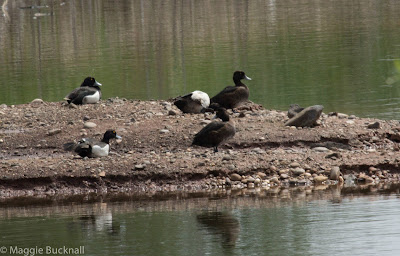 |
| The group with David and Linda. |
Well, for me it was meeting the local regular, Busby. It was a surprise to turn around and see a 38 year old Macaw, rescued from a pet shop and much loved by his owner. You will often see them taking the air and seeing the locals. Busby is a real character, just ask his owner, who can also tell you some interesting stories.
 |
| Busby |
 |
| Busby |
The first area we take a look at will be the Heronry which is opposite the reeds. Here you will often see Herons fly past back to their nests. If you are lucky you may see Reed Buntings hovering around, and over by the feeders you should see Blue Tits, Greenfinches, and Great Tits, along with Goldfinches. They will normally feed off the feeders. But do take a look on the ground you may see a Dunnock. They only like to feed on the ground.
 | ||
| Heron surveying the area |
Here are a selection of flowers just to give you some idea of the type of wild flowers you can see at this time of year.
 |
| Hyacinthoides non-scripta - Bluebell |
 |
Rannunculaceae Buttercup |
 |
| Stitchwort |
 |
Umbelliferae Cow Parsley |
You can smell Wild Garlic as you walk down the pathway and head towards the main reserve and what an amazing herb it is. Its botanical name is Allium ursinum – is a wild relative of chives which are native to Europe and Asia. Do note that the leaves of wild garlic look like Lily of the Valley, and these must not be consumed, since they are very toxic. To tell the difference, if you rub the leaves between your fingers it will give off a pungent garlic aroma. If it does not, then its not wild garlic, so avoid at all cost.
Garlic is also known as Russian penicillin and was used to help individuals with respiratory tract infections. During World War I it was often used to help treat infections since it has antibiotic properties.
 | |||||
| Allium ursinum –Wild Garlic |
As I was walking, I stopped and looked back and was very lucky to see a Dunnock fly in and start eating insects from the ground. Unfortunately the quality of my photo of this lovely bird is not that brilliant, since it was so far away. At the time I had no idea what it was. It was only later when checking with David that it was confirmed as a Dunnock. I was pleased I was able to spot it.
I am afraid you really do have to be so patient to see some of the birds that you often hear people talk about. Birding is a wonderful thing, but you must have patience. As they say "Patience is a Virtue"
"The proverb has been traced back to 'Piers Plowman' (1377) by William Langland and is similar to the Latin, Maxima enim..patientia virtus (Patience is the greatest virtue) and the French, Patience est une grant vertu. (Patience is a great value.)"
This is the sound of a Dunnock so one thing to do is to start to recognise the sound of birds. Click here
 |
| Prunella modularis Dunnock |

Not only will you see birds, but different varieties of insects such as bees, wasps and butterflies. Here we have a selection of some we saw.

As we made our way down to the main reserve.
 |
| Which way to go! |
We saw various Waterfowl birds, such as the Shoveler, Male and Female Mallards, Canadian Geese and Mute Swans, just to name a few.
 |
| Safely landed - Mute Swans. They have orange bills with black prominent base. |
 |
| Mum and babies, but growing up fast. |
 |
| Common Tern |
 |
| Canada Geese |
 |
| Get ready for landing |
 |
| Bombs away |
Not only did we see some wonderful waterfowl, but the group was lucky to hear and see Reed Buntings, Whitethroat, Cettis Warbler, Black Cap and the cheeky Robin. I was not so lucky to see all of these but here is my final display. Although I am pleased to inform that I have finally seen the Whitethroat, and one day I will be even luckier to capture it by camera.
 |
If you are very patient and bring some meal-worm with you, he will fly down and take the food out of your hand. |
 |
| Female Reed Bunting |
click here for the Reed Bunting song
 |
| Female Reed Bunting |
Then wait and you should see them fly in and out of the reeds
 |
| Male Reed Bunting hiding |
The males will have a black heads and throats, whereas the female has a brown head.
Sometimes you may get the Male mixed up with a Black Cap. So if you see a bird with a black head and a black throat, it will be a Reed Bunting.
 |
| Male Reed Bunting |
 |
| Male Reed Bunting |
Finally and not last the lovely Longhorns. Unfortunately, they were hiding and I was only able to capture this one on camera.....resting and enjoying life.
Quote
"Nature thrives on patience; man on impatience"
Paul Boese
References
Alaskan Range (ND) Patience Is A Virtue. [accessed 20.05.13]http://www.openwriting.com/archives/2012/06/patience_is_a_v_2.php
Petrovska BB, Cekovska S (2010) Extracts from the history and medical properties of garlic.Pharmacogn Rev. 4(7): 106–110
RSPB (ND) Dunnock. [accessed 20.05.13] www.rspb.org.uk/wildlife/birdguide/name/d/dunnock/index.aspx
RSPB (ND) Bird Guide.[accessed 20.05.13] http://www.rspb.org.uk/wildlife/birdguide/name/m/muteswan/index.aspx
Sterry P (2008) Collins Complete Guide to British Wild Flowers: A Photographic Guide to Every Common Species. UK: Collins.




